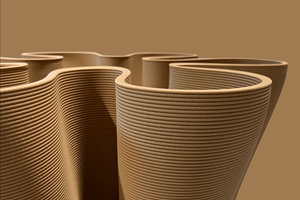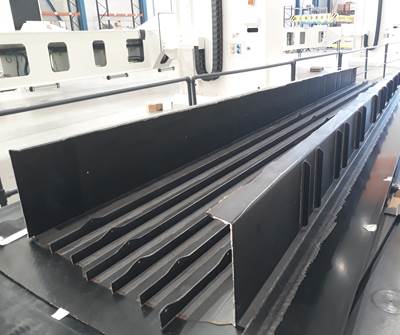Clean Sky 2 outer wing box demonstrator validates OOA LRI, shimless assembly and SHM
Full-scale wing box project achieves TRL 5 with 2% weight reduction and 4% reduction in recurring production costs through improved manufacturing efficiency and assembly processes.

The Outer Wing Box in its testing configuration. Source | Clean Sky 2
A milestone has been achieved with the testing of the Clean Sky 2 outer wing box (OWB) full-scale demonstrator which has achieved technology readiness level (TRL) 5, validating its feasibility for future applications and providing a foundation for advancements in aerospace manufacturing that will enable weight reduction and more efficient assembly techniques.
The OWB demonstrator project — — is representative of a regional aircraft wing configuration that aimed to validate emerging technologies such as out-of-autoclave liquid resin infusion (OOA LRI), in situ consolidation of thermoplastic composites, shimless assembly and structural health monitoring (SHM) sensor systems. It was a collaborative effort involving multiple aerospace industry leaders and research institutions, including Hellenic Aerospace Industry (HAI), the University of Nottingham in VADIS, the University of Naples (UNINA), ItalSystem Srl and and the Italian Aerospace Research Centre (CIRA) in Air Green 2. The topic manager was Leonardo.
The full-scale OWB demonstrator, the structural core of an aircraft wing (and a key interface with the aircraft fuselage), is approximately 9.1 meters in width at the root rib of about 1.3 meters, and a width at the tip rib of about 0.7 meter. It includes several components manufactured via LRI/OOA processes, comprising:
- One stiffened upper panel including a removable panel
- One stiffened lower panel manufactured in one shot by a co-infusion of skin, stringers and rib feet
- Two LRI spars
- Fourteen LRI ribs
- Four metallic ribs.
The primary goal of the OWB demonstrator was to validate advanced manufacturing processes and innovative assembly methodologies at full-scale level, as Vittorio Ascione, Clean Sky 2 REG IADP project manager at Leonardo notes.
“To have the assurance of the assessment of some technologies, you need to reach the full scale that will be used on the aircraft,” Ascione says. “Because by means of testing at full scale, you can find new issues that you never would be able to detect or foresee with a small scale demonstrator. Having a full-scale demonstrator included in the process gave us that assurance that all worked well, and the assessment of technologies was really complete. This was the first time that we had produced a more than 9-meter-long demonstrator — in itself a significant achievement — adding the possibility to check these new technologies at full size.”
However, developing large, integrated composite panels presented numerous challenges. Key technologies used to overcome these challenges included, OOA, LRI, shimless assembly, determinant assembly and part-to-part assembly:
OOA LRI process
This process was designed to manufacture large integral stiffened composite panels with greater efficiency and reduced environmental impact. Unlike traditional autoclave-based composites manufacturing, the use of OOA LRI, compared to a traditional composite process that uses prepreg in an autoclave, enables components to be “cured” using less energy (as pressurization during curing is not necessary), and large refrigerators are not required to maintain the composite material before starting production. This approach resulted in a 2% weight reduction, which would — when applied to an in-service OWB — translate into fuel savings and emissions reductions.
Shimless assembly
The development of shimless assembly techniques necessitated the seamless integration of scanning, reverse engineering and CAM software.
“Traditionally, wing box assembly involves using shims to close gaps between ribs and panels. This process is time-consuming and expensive,” explains Giuseppe Totaro, Clean Sky 2 REG IADP OWB demo leader at Leonardo. “Our new approach uses digital twins and precise machining to create a shimless configuration.”
Shimless assembly is based on the study of tolerance propagation, and on a “determinant assembly approach” (DAA) This is a manufacturing and assembly methodology that ensures parts fit together with minimal adjustments, reducing the need for shims, rework or manual fitting during the assembly process. The DAA relies on precise engineering, digital design and tolerance management to create components that align perfectly when assembled. This approach, developed in Project VADIS (Variance Aware Determinate Assembly Integrated System), allows tolerances to be optimized by increasing them where possible with a reduction in manufacturing costs.
This challenge was also addressed through the refinement of automatic software routines, ensuring compatibility with existing industry tools, such as Catia. Using reverse engineering, automatic software routines were developed to scan panel surfaces and determine final rib surfaces for precise part-to-part assembly — a method of creating assemblies by joining two or more parts, where the parts can either touch or intrude into each other, and can be used to create a new part or subassembly.
The final demonstrator, measuring more than 9 meters in length, successfully demonstrated the efficiency of this approach by reducing the need for shims and enabling one-pass finished hole execution instead of multiple passes, leading to a 4% reduction in manufacturing costs.
Structural health monitoring (SHM)
A key feature in the project was the integration of SHM piezoelectric sensors and optical fibers which were strategically embedded in the wing box in order to monitor the stresses and condition of the OWB structure. This was successfully tested, proving its effectiveness in detecting, localizing and tracking damage propagation in the composite structure, ensuring long-term reliability and safety.
“We collaborated with the Air Green 2 consortium to install electric sensors inside the complex wing box. This was done at full scale to validate the technologies, which was particularly significant given the 9.1-meter demonstrator length,” says Leonardo’s Ascione.
This technology not only enhances aircraft safety by enabling real-time monitoring, it also helps with predictive maintenance by facilitating the collection of data that can be used to forecast when maintenance and repairs might be needed in the future.
Following rigorous testing, including a full-scale static bending test, the project successfully validated these technologies, confirming a strong correlation between experimental data and numerical models. This validation was critical in achieving TRL 5, demonstrating the feasibility of these technologies for future aerospace applications.
Future applications and next steps
The success of the OWB demonstrator paves the way for further advancements in European aerospace manufacturing: The processes developed throughout the course of the project — notably the full-scale LRI manufacturing process for full-scale stiffened panels with integrated stringers, ribs and spars — can be applied not just for regional aircraft but for other aircraft sizes too (both larger and smaller), where production costs and environmental impact requirements are more challenging.
“The technologies developed have already been applied to other Clean Aviation projects,” says Ascione. “The LRI process is particularly suitable for wing, horizontal and vertical tail configurations with thicker composite structures.”
The development of the LRI process to produce stiffened wing panels will be continued in the Clean Aviation HERWINGT project, where a different formulation of the resin will be studied to increase performance in terms of glass transition temperature and lighting strike protection.
The part-to-part assembly technology, developed in OWB, has proven to hold potential, and will be further developed in upcoming national research projects.
Related Content
Plant tour: Aernnova Composites, Toledo and Illescas, Spain
RTM and ATL/AFP high-rate production sites feature this composites and engineering leader’s continued push for excellence and innovation for future airframes.
Read MoreSulapac introduces Sulapac Flow 1.7 to replace PLA, ABS and PP in FDM, FGF
Available as filament and granules for extrusion, new wood composite matches properties yet is compostable, eliminates microplastics and reduces carbon footprint.
Read MoreBladder-assisted compression molding derivative produces complex, autoclave-quality automotive parts
HP Composites’ AirPower technology enables high-rate CFRP roof production with 50% energy savings for the Maserati MC20.
Read MoreReinforcing hollow, 3D printed parts with continuous fiber composites
Spanish startup Reinforce3D’s continuous fiber injection process (CFIP) involves injection of fibers and liquid resin into hollow parts made from any material. Potential applications include sporting goods, aerospace and automotive components, and more.
Read MoreRead Next
Advancing the OOA infused wing box
MTorres integrates lower cover, front and rear spars into unitized flying demonstrator using one-shot, low-cost, portable production.
Read MoreHERWINGT project to design novel composite wing configuration for future regional aircraft
Pioneered wing architecture, more integrated systems and new material technologies are being explored for 20% weight reduction, 50% fuel burn reduction and to enable a hybrid-electrical use case.
Read MoreInside the MFFD — CW's coverage of the Clean Aviation multifunctional fuselage demonstrator
ÂÌñÏ×ÆÞ rounds up coverage of the MFFD project over the past decade. Now complete, the MFFD illustrates numerous processes and technologies for manufacturing primary aerospace structures using thermoplastic composites.
Read More












